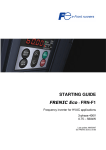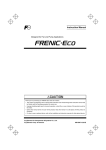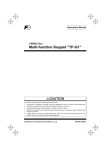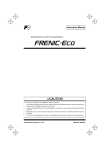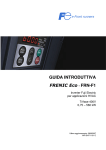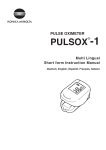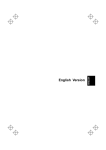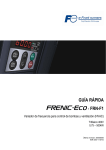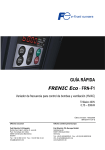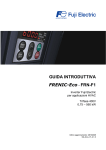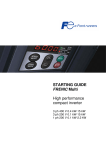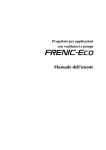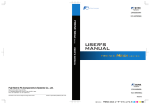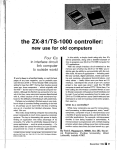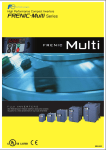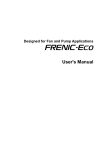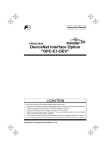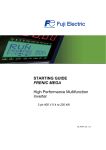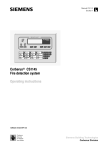Download STARTING GUIDE FRENIC Eco . FRN-F1 - Q-TECH
Transcript
DRAFT STARTING GUIDE FRENIC Eco . FRN-F1 Fuji Electric frequency inverter for HVAC applications 3-phase 400V 0.75 – 500kW Fuji Electric GmbH . Goethering 58 . 63067 Offenbach/Main . Germany Tel.: +49 (0)69 669029-0 . Fax +49 (0)69 669029-58 . [email protected] . www.fujielectric.de FRN-F1 CONTENT Chapter Page 1. SAFETY INFORMATION AND CONFORMITY TO STANDARDS……………………………………………... 1 1.1 Safety Information…………………………………………………………………………………………………… 1 1.2 Conformity to Standards…………………………………………………………………………………………….. 3 1.2.1 Conformity to European Standards………………………………………………………………………………... 3 1.2.2 Conformity to Low Voltage Directive………………………………………………………………………………. 3 2. MECHANICAL INSTALLATION…………………………………………………………………………………….. 4 2.1 Installing the Inverter………………………………………………………………………………………………… 4 2.2 Mounting direction…………………………………………………………………………………………………… 4 2.3 Removing and Mounting the Terminal Block cover and the Front Cover……………………………………… 4 3. ELECTRICAL INSTALLATION……………………………………………………………………………………... 6 3.1 Power Terminals……………………………………………………………………………………………………... 6 3.2 Control Terminals…………………………………………………………………………………………………….. 7 3.2.1 Control Terminals Connection……………………………………………………………………………………… 8 4. OPERATION USING THE KEYPAD……………………………………………………………………………….. 9 5. QUICK STARTING COMMISSIONING……………………………………………………………………………. 10 5.1 Running the Motor for a Test……………………………………………………………………………………….. 10 5.1.1 Inspection and preparation prior to powering on…………………………………………………………………. 10 5.1.2 Turning on power and checking……………………………………………………………………………………. 10 5.1.3 Preparation before running the motor for a test--Setting function code data…………………………………. 10 5.1.4 Procedure for Test Run……………………………………………………………………………………………… 11 5.2 Operation……………………………………………………………………………………………………………… 11 6. FUNCTION CODES…………………………………………………………………………………………………. 12 6.1 Function Codes Tables……………………………………………………………………………………………… 12 6.2 Overview of Function Codes……………………………………………………………………………………….. 14 7. PROTECTIVE FUNCTIONS………………………………………………………………………………………... 22 7.1 Protection / Maintenance Function (Parameter H98)……………………………………………………………. 22 7.2 Dew Condensation Protection (Parameter J21)………………………………………………………………….. 23 8. SPECIFICATIONS AND EXTERNAL DIMENSIONS…………………………………………………………….. 24 8.1 Inverter Specifications………………………………………………………………………………………………. 24 8.1.1 Standard Model – IP20 / IP00……………………………………………………………………………………… 24 8.1.2 Semi standard – IP54 with integral EMC filter and DCR………………………………………………………… 26 I FRN-F1 8.2 External Dimensions………………………………………………………………………………………………… 27 8.2.1 Inverter Standard Models.............................................................................................................................. 27 8.2.2 Inverter IP54 Models..................................................................................................................................... 28 8.3 Keypad Dimensions..................................................................................................................................... 29 9. OPTIONS……………………………………………………………………………………………………………… 30 Preface Thank you for purchasing our FRENIC-Eco series of inverters. This product is designed to drive a three-phase induction motor for fan and pump applications. Read through this starting guide and become familiar with proper handling and operation of this product. Please note that this starting guide should enable you to get familiar with the main functions and should help you to install the inverter. Not all functions are described here. For more detailed information please refer absolutely to the attached CD-ROM which contains the user manual (MEH456). Improper handling might result in incorrect operation, a short life, or even a failure of this product as well as the motor. Have this manual delivered to the end user of this product. Keep this starting guide and CD-ROM in a safe place until this product is discarded. Listed below are the other materials related to the use of the FRENIC-Eco. Read them in conjunction with this starting guide as necessary. • FRENIC-Eco User's Manual (MEH456) • RS485 Communication User's Manual (MEH448) • Catalogue (MEH442) • RS485 Communications Card "OPC-F1-RS" Installation Manual (INR-SI47-0872) • Relay Output Card "OPC-F1-RY" Instruction Manual (INR-SI47-0873) • Mounting Adapter for External Cooling "PB-F1" Installation Manual (INR-SI47-0880) • Panel-mount Adapter "MA-F1" Installation Manual (INR-SI47-0881) • Multi-function Keypad "TP-G1" Instruction Manual (INR-SI47-0890-E) • FRENIC Loader Instruction Manual (INR-SI47-0903-E) The materials are subject to change without notice. Be sure to obtain the latest editions for use. II FRN-F1 1. SAFETY INFORMATION AND CONFORMITY TO STANDARDS 1.1 Safety Information Read this manual thoroughly before proceeding with installation, connections (wiring), operation, or maintenance and inspection. Ensure you have sound knowledge of the device and familiarize yourself with all safety information and precautions before proceeding to operate the inverter. Safety precautions are classified into the following two categories in this manual. Application • • • FRENIC-Eco is designed to drive a three-phase induction motor. Do not use it for single-phase motors or for other purposes. Fire or an accident could occur. FRENIC-Eco may not be used for a life-support system or other purposes directly related to the human safety. Though FRENIC-Eco is manufactured under strict quality control, install safety devices for applications where serious accidents or material losses are foreseen in relation to the failure of it. An accident could occur. Installation • • Install the inverter on a nonflammable material such as metal. Otherwise fire could occur. Do not place flammable matter nearby. Doing so could cause fire. • • Do not support the inverter by its terminal block cover during transportation. Doing so could cause a drop of the inverter and injuries. Prevent lint, paper fibers, sawdust, dust, metallic chips, or other foreign materials from getting into the inverter or from accumulating on the heat sink. Otherwise, a fire or an accident might result. Do not install or operate an inverter that is damaged or lacking parts. Doing so could cause fire, an accident or injuries. Do not get on a shipping box. Do not stack shipping boxes higher than the indicated information printed on those boxes. Doing so could cause injuries. • • • Maintenance and inspection, and parts replacement • • • • Turn the power OFF and wait for at least five minutes for models of 30 kW or below, or ten minutes for models of 37 kW or above, before starting inspection. Further, check that the LED monitor is unlit, and check the DC link bus voltage between the P (+) and N (-) terminals to be lower than 25 VDC. Otherwise, electric shock could occur. Maintenance, inspection, and parts replacement should be made only by qualified persons. Take off the watch, rings and other metallic matter before starting work. Use insulated tools. Otherwise, electric shock or injuries could occur. Disposal • Handle the inverter as an industrial waste when disposing of it. Otherwise injuries could occur. Others • Never attempt to modify the inverter. Doing so could cause electric shock or injuries. Wiring • When wiring the inverter to the power source, insert a recommended molded case circuit breaker (MCCB) or residual-current-operated protective device (RCD)/earth leakage circuit breaker (ELCB) (with overcurrent protection) in the path of power lines. Use the devices within the recommended current range. Chapter 1: Safety Information and Conformity to Standards 1 FRN-F1 • • • • Use wires in the specified size. Otherwise, fire could occur. Do not use one multicore cable in order to connect several inverters with motors. Do not connect a surge killer to the inverter's output (secondary) circuit. Doing so could cause fire. Ground the inverter following Class C or Class D specifications or national/local electric code, depending on the input (primary) voltage of the inverter. Otherwise, electric shock could occur. • • • • Qualified electricians should carry out wiring. Be sure to perform wiring after turning the power OFF. Otherwise, electric shock could occur. Be sure to perform wiring after installing the inverter body. Otherwise, electric shock or injuries could occur. Ensure that the number of input phases and the rated voltage of the product match the number of phases and the voltage of the AC power supply to which the product is to be connected. Otherwise fire or an accident could occur. Do not connect the power source wires to output terminals (U, V, and W). Doing so could cause fire or an accident. Generally, control signal wires are not enforced- insulated. If they accidentally touch any of hot power lines, their insulation coat may break for any reasons. In such a case, an extremely high voltage may be applied to the signal lines. Make a complete remedy to protect the signal line from contacting any hot high voltage lines. Otherwise, an accident or electric shock could occur. • • • • Wire the three-phase motor to terminals U, V, and W of the inverter, aligning phases each other. Otherwise injuries could occur. The inverter, motor and wiring generate electric noise. Take care of malfunction of the nearby sensors and devices. To prevent the motor from malfunctioning, implement noise control measures. Otherwise an accident could occur. Setting control switches • Before setting up any internal control switches, turn OFF the power, wait more than five minutes for models of 30 kW or below, or ten minutes for models of 37 kW or above, and make sure, using a multimeter or a similar instrument, that the DC link bus voltage between the terminals P (+) and N (-) has dropped below a safe voltage (+25 VDC). Otherwise electric shock could occur. Operation • Be sure to install the terminal block cover and the front cover before turning the power ON. Do not remove the covers while power is applied. Otherwise electric shock could occur. • • • Do not operate switches with wet hands. Doing so could cause electric shock. If the retry function has been selected, the inverter may automatically restart and drive the motor depending on the cause of tripping. (Design the machinery or equipment so that human safety is ensured after restarting.) If the stall prevention function (current limiter), automatic deceleration, and overload prevention control have been selected, the inverter may operate at an acceleration/deceleration time or frequency different from the commanded ones. Design the machine so that safety is ensured even in such cases. Otherwise an accident could occur. The STOP key is only effective when function setting (Function code F02) has been established to enable the STOP key. Prepare an emergency stop switch separately. If you disable the STOP key priority function and enable operation by external commands, you cannot emergency-stop the inverter using the STOP key on the built-in keypad. If an alarm reset is made with the Run command signal turned ON, a sudden start will occur. Ensure that the Run command signal is turned OFF in advance. Otherwise an accident could occur. If you enable the "restart mode after instantaneous power failure" (Function code F14 = 3, 4, or 5), then the inverter automatically restarts running the motor when the power is recovered. (Design the machinery or equipment so that human safety is ensured after restarting.) If you set the function codes wrongly or without completely understanding this instruction manual and the FRENIC-Eco User's Manual (MEH456), the motor may rotate with a torque or at a speed not permitted for the machine. An accident or injuries could occur. Do not touch the inverter terminals while the power is applied to the inverter even if the inverter stops. Doing so could cause electric shock. • • • • Do not turn the main circuit power (circuit breaker) ON or OFF in order to start or stop inverter operation. Doing so could cause failure. Do not touch the heat sink because they become very hot. Doing so could cause burns. Setting the inverter to high speeds is easy. Before changing the frequency (speed) setting, check the specifications of the motor and machinery. The brake function of the inverter does not provide mechanical holding means. Injuries could occur. • • • • • GENERAL PRECAUTIONS Drawings in this manual may be illustrated without covers or safety shields for explanation of detail parts. Restore the covers and shields in the original state and observe the description in the manual before starting operation. Chapter 1: Safety Information and Conformity to Standards 2 FRN-F1 1.2 Conformity to Standards 1.2.1 .Conformity to European Standards The CE Approved on Fuji products indicates that they comply with the essential requirements of the Electromagnetic Compatibility (EMC) Directive 89/336/EEC issued by the Council of the European Communities and the Low Voltage Directive 73/23/EEC. Only the models with a built-in EMC-compliant filter that bear a CE Approved are compliant with the EMC Directive. Inverters that bear a CE Approved are compliant with the Low Voltage Directive. ¦ The FRENIC-Eco series of inverters with conformity to the following standards: Low Voltage Directive EN50178:1997 EMC Directives EN61800-3:1996 + A11: 2000 EN55011: 1998 + A1:1999 CAUTION The FRENIC-Eco series of inverters are categorized as a "restricted sales distribution class" provided in the EN61800-3. When you use these products with any home appliance or office equipment, you may need to take appropriate countermeasures to reduce or eliminate any noise emitted from these products. 1.2.2 Conformity to Low Voltage Directive General-purpose inverters are subject to the regulations set forth by the Low Voltage Directive in Europe. Fuji has obtained a certification of compliance from a European test organization for its FRENIC-Eco series inverters and labels them with a CE Approved, which is a self-declaration with conformity to the Low Voltage Directive. Considerations when using FRENIC-Eco as a product with conformity to Low Voltage Directive If you wish to use a FRENIC-Eco series inverter as a product with conformity to the Low Voltage Directive, refer to the related guidelines. Chapter 1: Safety Information and Conformity to Standards 3 FRN-F1 2. Mechanical Installation 2.1 Installing the Inverter Mounting base The inverter should be mounted on a base made of material that can withstand heat sink temperature, which can rise up to 90ºC approx. during inverter operation. Clearances Ensure that the minimum clearances indicated are maintained at all times. When installing the inverter in the enclosure of your system, take extra care with ventilation inside the enclosure as the temperature around the inverter will tend to increase. Do not install the inverter in a small enclosure with poor ventilation. *For 37Kw or above a 50 mm clearance is needed instead of 10 mm (left and right sides). As long as the ambient temperature is 40°C or lower, 5.5 kW or lower inverters may be mounted side-by-side without any gap between them. For others inverters, please follow the clearances needed. 2.2 Mounting Direction Horizontal layout is recommended when two or more inverters are to be installed in an equipment or enclosure. If it is necessary to mount the inverters vertically, install a partition plate or the like between the inverters so that any heat radiating from an inverter will not affect the one/s above. 2.3 Removing and Mounting the Terminal Block (TB) Cover and the Front Cover To remove the TB cover, loosen the fastening screw on it, hold the dimple (labelled “PULL”), and pull it up towards you. To remove the front cover, hold it with both hands, slide it downward, disengage the latch at the top from the inverter, tilt the front cover toward you, and pull it upward. Chapter 2: Mechanical Installation 4 FRN-F1 For inverters with a capacity of 30 kW or below (for others please refer to user's manual chapter 2). For mounting the covers, please refer to next snapshots and follow removing instructions in the opposite way. Chapter 2: Mechanical Installation 5 FRN-F1 3. Electrical Installation 3.1. Power Terminals Symbol * Perform wiring as necessary Wiring procedure Terminal function L1/R, L2/S, L3/T Main power inputs U, V, W Inverter outputs R0, T0 * P1, P(+) * P(+), N(-) * R1, T1 * Gx2 Description Connect the 3-phase input power lines. Connect a 3-phase motor Auxiliary power input for the control circuit For a backup of the control circuit power supply, connect AC power lines same as that of the main power input. Connect a DC reactor (DCR) for improving power factor (an option DC reactor connection for the inverter whose capacity is 55 kW or below). Connect a DC link bus of other inverter(s). An optional regenerative DC link bus converter is also connectable to these terminals. Auxiliary power input for the fans Normally, no need to use these terminals. Use these terminals for an (Refer to chapter 8.4.1 of user's auxiliary power input of the fans in a power system using a power manual) regenerative PWM converter (RHC series). Grounding terminals for the inverter’s chassis (or case) and motor. Earth one of the terminals and connect the grounding terminal of the Grounding for inverter and motor motor. Inverters provide a pair of grounding terminals that function equivalently. Switching connectors (for models 400 V series 55 kW or above. Refer to chapter 8.4.1 of user's manual.) Chapter 3: Electrical Installation 6 FRN-F1 3.2. Control Terminals The FRENIC ECO inverter has 7 digital inputs (two fixed and five programmable), 3 programmable transistor outputs and 2 relay outputs (one fixed and one programmable). Symbols Type Programmable Example of use Description PLC Connects to PLC output signal power supply -- -- To turn ON or OFF digital inputs using a relay or a PLC. 24VDC max. current 50mA CM Digital common -- -- Two common terminals for digital input signal terminals FWD Run forward command YES -- External run command UP REV Run reverse command YES -- External run command DOWN X1-X5 Digital inputs YES Speed selection Coast to stop etc. Programmable digital inputs Program the required function in parameters E01 through E05 Y5 A/C General purpose relay output YES MC control signal Inverter ready 30 A,B,C Alarm relay output YES Signal to control system that the inverter has an alarm Y1-Y3 Transistor outputs YES Same as relay output Y5 / 30A Programmable transistor outputs. Program the required function in parameters E20 through E22 CMY Transistor output common -- -- Common terminal for transistor output signal terminals Electrical specification for digital inputs (X1 to X5): Item Programmable relay contact output. Program the required function in parameters E24 / E27 Electrical specification for transistor outputs: Min. Max. ON level 0V 2V OFF level 22 V 27V ON level 22 V 27V OFF level 0V 2V Maximum load current at ON 50 mA Operation current at ON (Input voltage is at 0V) 2.5 mA 5 mA Leakage current at OFF 0.1 mA Allowable leakage current at OFF - 0.5 mA Operation voltage (SINK) Operation voltage (SOURCE) Electrical specification for relay contact outputs: Chapter 3: Electrical Installation Item Operation voltage Max. ON level 3V OFF level 27 V 48 VDC, 0.5 A 7 FRN-F1 3.2.1 Control Terminals Connection Digital inputs and outputs can be operated both in NPN (sink) and PNP (source) logic. a) DIGITAL INPUTS: Refer to the user's manual MEH456 for connection examples. SW1 SINK SW1 SOURCE The switch SW1 located on the control board defines the logic used for digital inputs. Factory default setting is source. ? SINK LOGIC: Digital input ON giving 0 volts. ? SOURCE LOGIC: Digital input ON giving 24 volts. b) TRANSISTOR OUTPUTS: Refer to the user's manual MEH456 for connection examples. To decide what logic to use, there is no switch as before. Connecting “PLC” terminal to the transistor common “CMY” terminal you will have PNP logic. Connecting “CM” terminal to the transistor common “CMY” terminal you will have NPN logic. c) RELAY OUTPUTS: Y5A/C RELAY: you can switch its output mode between “Active ON” (the terminals [Y5A] and [Y5C] are short-circuited if the signal is active) and “Active OFF” (the terminals [Y5A] and [Y5C] are opencircuited if the signal is active). 30A 30B 30C Y5A 30A/B/C RELAY: switching of the normal/negative logic output is applicable to the following two contact outputs: "Terminals [30A] and [30C] are short-circuited for ON signal output (Active ON)" or "the terminals [30B] and [30C] are short-circuited (non-excite) for ON signal output (Active OFF)." Chapter 3: Electrical Installation Y5C 8 FRN-F1 4. OPERATION USING THE KEYPAD LED monitor As shown in the figure at right, the keypad consists of a four-digit LED monitor, 5 LED indicators, and six keys. The keypad allows you to start and stop the motor, monitor running status, and switch to the menu mode. In the menu mode, you may set the function code data, monitor I/O signal states, maintenance information, and alarm information. Item LED indicators Program/ Reset key RUN key Function/ Data key STOP key Up key Monitor, LED indicators and Keys Down key Functions Four-digit, 7-segment LED monitor which displays the following according to the operation modes. n In Running Mode: Running status information (e.g., output frequency, current, and voltage) n In Programming Mode: Menus, function codes and their data n In Alarm Mode: Alarm code, which identifies the error factor if the protective function is activated. LED Monitor Program/Reset key which n In Running Mode: n In Programming Mode: n In Alarm Mode: switches the operation modes of the inverter. Pressing this key switches the inverter to Programming Mode. Pressing this key switches the inverter to Running Mode. Pressing this key after removing the error factor will switch the inverter to Running Mode. Function/Data key which switches the operation you want to do in each mode as follows: n In Running Mode: Pressing this key switch the information to be displayed concerning the status of the inverter (output frequency (Hz), output current (A), output voltage (V), etc.). n In Programming Mode: Pressing this key displays the function code and sets the data entered with and keys. n In Alarm Mode: Pressing this key displays the details of the problem indicated by the alarm code that has come up on the LED monitor. Operation Keys RUN key. Press this key to run the motor. STOP key. Press this key to stop the motor. and UP and DOWN keys. Press these keys to select the setting items and change the function data displayed on the LED monitor. RUN LED Lights when any run command to the inverter is active, In Programming and Alarm modes, you cannot run the inverter even if the indicator lights. KEYPAD CONTROL LED Lights when the inverter is running by the run command from the LED Indicators Unit and Mode expression by the three LED indicators key. The lower 3 LED indicators identify the unit of numeral displayed on the LED monitor in Running Mode by combination of lit and unlit states of them in the category shown below. kW, A, Hz, r/min and m/min While the inverter is in Programming Mode, the LEDs at both ends of the lower indicators light. In Programming Mode: ¦ Hz ? A ¦ kW Chapter 4: Keys and LED on the Keypad 9 FRN-F1 5. QUICK STARTING COMMISSIONING 5.1 Running the Motor for a Test 5.1.1 Inspection and preparation prior to powering on Check the following prior to starting powering on. (1) Check if connection is correct. Especially check if the power wires are connected to the inverter input terminals L1/R, L2/S and L3/T, and output terminals U, V and W respectively and that the grounding wires are connected to the ground electrodes correctly. Note that FRENIC-Eco series inverter is designed for three phase input and driving three phase motors. • • Do not connect power supply wires to the inverter output terminals U, V, and W. Otherwise, the inverter may be broken if you turn the power on. Be sure to connect the grounding wires of the inverter and the motor to the ground electrodes. Otherwise, electric shock may occur. (2) Check for short circuits between terminals and exposed live parts and ground faults. (3) Check for loose terminals, connectors and screws. (4) Check if the motor is separated from mechanical equipment. (5) Turn the switches off so that the inverter does not start or operate erroneously at power-on. (6) Check if safety measures are taken against runaway of the system, e.g., a defense to protect people from unexpectedly Figure 5.1 Connection of Main Circuit Terminals approaching your power system. 5.1.2 Turning on power and checking Turn the power on and check the following points. This is a case when no function code data is changed from the factory setting. (1) Check if the LED monitor displays "*00 " (means that the frequency command is 0 Hz) that is blinking. (See Figure 5.2.) If the LED monitor displays numbers except "*00 " then press the / key to set "*00 " as the frequency command. (2) Check if a built-in cooling fan rotates. Figure 5.2 Display of the LED Monitor after Power-on 5.1.3 Preparation before running the motor for a test--Setting function code data Before starting running the motor, set function code data specified in Table 5.1 to the motor ratings and your system design values. For the motor, check the rated values printed on the nameplate of the motor. For your system design values, ask system designers about them. & For details about how to change function code data, refer to Chapter 4. Refer to the function code H03 in Chapter 6 "FUNCTION CODES" for the factory default setting of motor parameters. If any of them is different from the default setting, change the function code data. Chapter 5: Quick Starting Commissioning 10 FRN-F1 Table 5.1 Settings of Function Code Data before Driving the Motor for a Test Function code Name Function code data F 04 Base frequency F 05 Rated voltage (at base frequency) F 03 Maximum frequency F 07 Acceleration time 1* F 08 Deceleration time 1* P 02 P 03 P 99 Motor parameter (Rated capacity) Motor ratings (printed on the Motor parameter (Rated current) nameplate of the motor) Motor Selection Motor ratings (printed on the nameplate of the motor) System design values * For a test-driving of the motor, increase values so that they are longer than your system design values. If the set time is short, the inverter may not start running the motor. Factory setting 50.0 (Hz) 0 (V) (Output voltage interlocked with the input voltage) 50.0 (Hz) 20.0 (sec) 20.0 (sec) Applicable motor rated capacity Rated current of applicable motor 0: Characteristic of ICE motor. 5.1.4 Procedure for Test Run (1) Turn the power on and check that the LED monitor blinks while indicating the *00 Hz frequency. (2) Set the frequency to a low frequency such as 5 Hz, using the / key. (Check that frequency command blinks on the LED monitor.) (3) Press the key to start running the motor in the forward direction. (Check that the frequency command is displayed on the LED monitor correctly.) (4) To stop the motor, press the key. <Check the following points> • Check if the direction of rotation is forward. • Check for smooth rotation without motor humming or excessive vibration. • Check for smooth acceleration and deceleration. When no abnormality is found, press the key again to start driving the motor, and increase the frequency command using the / key. Check the above points for the test-driving of the motor. ---------------------------------------------------------------------------------------------------------------------------------------------------5.2 Operation After confirming normal operation by performing a test run, make mechanical connections (connections of the machine system) and electrical connections (wiring and cabling), and set the necessary parameters properly before starting a production run. Depending on the conditions of the production run, further adjustments can be required, such as adjustments of torque boost (F09), acceleration time (F07), and deceleration time (F08). Make sure to set relevant function codes properly. Chapter 5: Quick Starting Commissioning 11 FRN-F1 6. FUNCTION CODES 6.1 Function Codes Tables Function codes enable the FRENIC-Eco series of inverters to be set up to match your system requirements. Each function code consists of a 3-letter string. The first letter is an alphabet that identifies its group and the following two letters are numerals that identify each individual code in the group. The function codes are classified into eight groups: Fundamental Functions (F codes), Extension Terminal Functions (E codes), Control Functions of Frequency (C codes), Motor Parameters (P codes), High Performance Functions (H codes), Application Functions (J codes), Link Function (y codes) and. Option Function (o codes) To determine the property of each function code, set data to the function code. For Option function (o codes), refer to the instruction manual for the option. n Using negative logic for programmable I/O terminals The negative logic signaling system can be used for the digital input and output terminals by setting the function codes specifying the properties for those terminals. Negative logic refers to inverted ON/OFF (logical value 1 (true)/0 (false)) state of input or output signal. An ON-active signal (the function takes effect if the terminal is short-circuited.) in the normal logic system is functionally equivalent to OFF-active signal (the function takes effect if the terminal is opened.) in the negative logic system. To set the negative logic system for an I/O signal terminal, display data of 1000s (by adding 1000 to the data for the normal logic) in the corresponding function code and then press the key. For example, if a coast-to-stop command (BX: data = 7) is assigned to any one of digital input terminals [X1] to [X3] by setting any of function codes E01 through E03, then turning (BX) on will make the motor coast to a stop. Similarly, if the coast-to-stop command (BX: data = 1007) is assigned, turning (BX) off will make the motor coast to a stop. The following tables list the function codes available for the FRENIC-Eco series of inverters. & If you find any [-] (not available here) mark in the related page column of the function code tables, refer to FRENIC-Eco User’s Manual (MEH456) for details. F codes: Fundamental functions Code F00 F01 F02 F03 F04 F05 F07 F08 F09 F10 F11 Name Data Protection Frequency command 1 Operation method Maximum frequency1 Base frequency 1 Rated voltage 1 Acceleration time 1 Deceleration time 1 Torque boost 1 Function Electric thermal overload relay 1 F12 F14 F15 F16 F18 F20 F21 F22 F23 F25 Level Time Restart after moment. power failure Frequency limiter high low Bias Frequency 1 DC Brake Frequency Level Time Starting frequency Stopping frequency Motor Sound F26 Chapter 6: Function Codes Carrier frequency Setting Range Factory default 0/1 0~3/5/7 0~4 25 ~ 120Hz 25 ~ 120Hz 0 / 160 ~ 500V 0.00 ~ 3600s 0.00 ~ 3600s 0.0 ~ 20.0 1/2 0.0 (Disable) 1 ~ 135% IN Mot. 0 0 0 50Hz 50Hz 400V 20s 20s Depending on the rated capacity 1 Nominal rated current (100%) of the motor 5.0 (22kW or 10.0 (30kW or below) below 1 70.0Hz 0.0Hz 0.00% 0.0Hz 0% 0.00s 0.5Hz 0.2Hz 0.5 ~ 75min 0~5 0~120Hz 0~120Hz -100.00~+100.00 % 0.0~60.0Hz 0 ~ 100% 0 / 0.01 ~ 30.0s 0.1 ~ 60.0Hz 0.1 ~ 60.0Hz 0.75~15 kHz (22kW or below) 0.75~10 kHz (30kW to 75kW) 0.75~6 kHz (90kW or above) See Page: 14 15 16 16 16 16 16 17 17 17 17 18 19 15kHz 19 10kHz 19 6kHz 19 12 FRN-F1 F27 F29 F30 F31 F33 F34 F35 F37 F43 F44 Tone Selection Analog Output (FMA) Level Function Pulsrate FMP Terminal Level Function Load selection / Auto torque boost/ Auto energy saving operation Selection Current limiter Level 0~3 0/1 0~200% 0 ~ 16 25 ~ 6000p/s 0% / 1 ~ 200% 0 ~ 16 0 0 100% 0 1440p/s 0% 0 0~5 1 0~2 20 ~ 120% IN Mot. 0 110% 17 The shaded function codes are applicable to the quick setup E codes : Extension Terminal functions Code Name E01 E02 E03 E04 E05 E20 E21 E22 E24 E27 E31 X1 Terminal Function X2 Terminal Function X3 Terminal Function X4 Terminal Function X5 Terminal Function Y1 Terminal Function Y2 Terminal Function Y3 Terminal Function Y5A / Y5B Terminal Function 30A/B/C Terminal Function Frequency detection FDT E34 Overload Early Warning Current detection E35 E40 E41 E43 E45 E46 E47 E48 E50 Setting Range 0 ~ 89 0 ~ 99 Level Level Timer Display coefficient A Display coefficient B LED Monitor Function Selection Language Contrast Speed item LCD Monitor*3 LED Monitor Coefficient for speed indication E51 Display Coefficient for Input W/h data E52 E61 E62 E63 E64 E65 E80 E81 E98 E99 Keypad (Menu display mode) Terminal 12 Terminal C1 Terminal V2 Analog input signal selection Saving of the digital set frequency Command loss detection Detect low torque Terminal command Level Level Timer FWD REV 0~120Hz 0 / 1~150% of the inverter current 0. 1~600.0s -999.00 ~ 999.00 -999.00 ~ 999.00 0 ~ 17 0/1 0~5 0 ~ 10 0~7 0.01 ~ 200.00 0.000 (Cancel/reset) 0.001 ~ 9999 0 ~2 0 ~ 3 / 5 / 20 0/1 0 / 1 ~ 120 / 999 0 ~ 150% 0.01 ~ 600.00s 0 ~ 89 Factory default 6 7 8 11 35 0 1 2 15 99 60Hz Nominal rated current (100%) of the motor 10.0s 100 0.0 0 0 1 5 0 30 0.010 0 0 0 0 0 999 20% 20s 98 99 19 The shaded function codes are applicable to the quick setup C codes: Control functions of frequency Code C01 C02 C03 C04 C05 C06 C07 Name Jump frequency Multistep frequency setting Chapter 6: Function Codes Setting Range 1 2 3 Hysterics Frequency 1 Frequency 2 Frequency 3 0.0 ~ 120Hz 0.0 ~ 30Hz 0.00 ~ 120.00Hz Factory default 0.0Hz 0.0Hz 0.0Hz 0.0Hz 0.00Hz 0.00Hz 0.00Hz 13 FRN-F1 C08 C09 C10 C11 C30 C32 C33 C34 C37 C38 C39 C42 C43 C44 C50 C51 C52 C53 Frequency 4 Frequency 5 Frequency 6 Frequency 7 Frequency command 2 Terminal 12 Signal filter Gain base point Terminal 1 Signal filter Gain base point Terminal V2 Signal filter Gain base point Analog input gain adjustment Analog input gain adjustment Analog input gain adjustment Bias Frequency command 1 Bias base point Base value Bias PID command 1 Bias base point Selection of normal / inverse operation for the frequency command 1 0~3/5/7 0.00 ~ 200.00 % 0.00 ~ 5.00s 0.00 ~ 100.00% 0.00 ~ 200.00 % 0.00 ~ 5.00s 0.00 ~ 100.00% 0.00 ~ 200.00 % 0.00 ~ 5.00s 0.00 ~ 100.00% 0.00Hz 0.00Hz 0.00Hz 0.00Hz 2 100.00% 0.05s 100% 0.00Hz 0.00Hz 0.00Hz 0.00Hz 0.00Hz 0.00Hz 0.00 ~ 100.0% 0.00% -100 ~ 100% 0.00 ~ 100.00% 0.00% 0.00% 0/1 0 Setting Range Factory default 4 Nominal rated capacity of the standard motor Nominal rated current of the standard motor 0 14 P codes: Motor parameters Code Name P01 Number of poles 2 ~ 22 P02 Rated capacity 0.01 ~ 1000 kW Rated current 0.00 ~ 2000A Auto tuning No-load current %R1 Setting %X Setting Selection 0/1/2 0.00 ~ 2000A 0.00 ~ 50.00% 0.00 ~ 50.00% 0~4 P03 P04 P06 P07 P08 P99 Motor 20 20 20 Nominal rated value of the standard motor 0 20 The shaded function codes are applicable to the quick setup *1 *2 *3 *4 When you make settings from the keypad, the incremental unit is restricted by the number of digits that the LED monitor can display. (Example) If the setting range is from -200.00 to 200.00, the incremental unit is: "1" for -200 to -100, "0.1" for -99.9 to -10.0 and for 100.0 to 200.0, and "0.01" for -9.99 to -0.01 and for 0.00 to 99.99. The H86 through H91 are displayed, but they are reserved for particular manufacturers. Unless otherwise specified, do not access these function codes. The H80 select 0.10 for models of 55 kW or above (400 V series), 0.20 for models 45 kW or below (400 V series). The H86 select 2 for models of 55 kW or above (400 V series), 0 for models 45 kW or below (400 V series). 6.2 Overview of Function Codes This section provides an overview of the function codes frequently used for the FRENIC-Eco series of inverter. & For details of the function codes given below and other function codes not given below, refer to the FRENIC-Eco User’s Manual (MEH456), Chapter 9 "FUNCTION CODES." F01 C30 Frequency Command 1 Frequency Command 2 Selects the devices to set the frequency command 1 for driving the motor. Chapter 6: Function Codes 14 FRN-F1 F01 To do this 0 Enable and keys on the built-in keypad. (Refer to Chapter 4 "OPERATION USING THE KEYPAD.") 1 Enable the voltage input to terminal [12] (0 to 10 VDC). 2 Enable the current input to terminal [C1] (4 to 20 mA DC). 3 Enable the sum of voltage and current inputs to terminals [12] and [C1]. See the two items listed above for the setting range and maximum frequencies. Note: If the sum exceeds the maximum frequency, the maximum frequency will apply. 5 Enable the voltage input to terminal [V2] (0 to 10 VDC). 7 Enable (UP) and (DOWN) commands assigned to the digital input terminals (UP) command (data=17) and (DOWN) command (data=18) to the input terminals [X1] to [X5]. Certain setting means (e.g., communication link and multistep frequency) have priority over these settings. For details, refer to the block diagram in the FRENIC-Eco User’s Manual (MEH456), Chapter 4, Section 4.2 "Drive Frequency Command Generator." F02 Operation Method Select the source issuing a run command for running the motor. F02 Running Mode Source of Run Command 0 Running per keypad (rotation direction: determined by terminal block) Enables the key and the key on the keypad to start and stop the motor. In the case of a standard keypad, the direction of rotation is determined by the commands given at terminals FWD and REV. In the case of a multi-functional keypad, there is no need to specify the direction of rotation. 1 External signal Enables the external signals given at terminals FWD and REV to run the motor. 2 Running per keypad (forward rotation) Enables the key and the key on the keypad to start and stop the motor. There is no need to specify the direction of rotation, since only forward rotation is allowed. In the case of a multi-functional keypad, only the FWD key is effective. 3 Running per keypad (reverse rotation) Enables the key and the key on the keypad to start and stop the motor. There is no need to specify the direction of rotation, since only reverse rotation is allowed. In the case of a multi-functional keypad, only the REV key is effective. When function code F02 = 0 or 1, the forward running/stopping function (FWD) and the reverse running /stopping function (REV) must be assigned to terminals FWD and REV, respectively. In addition to the function code F02 described above, there are several other means available with priority over F02. For details, refer to the block diagram in FRENIC-Eco User’s Manual (MEH456), Chapter 4, Section 4.3 "Drive Command Generator." Digital input commands (FWD) and (REV) are valid for specifying the motor rotation direction, and the commands (FWD2) and (REV2) are invalid. • If you have assigned the (FWD) or (REV) function to the [FWD] or [REV] terminal, you cannot change the setting of function code F02 while the terminals [FWD] and [PLC]* or the terminals [REV] and [CM]* are short-circuited. • If you have specified the external signal (F02 = 1) as the running command and have assigned functions other than the (FWD) or (REV) function to the [FWD] or [REV] terminal, caution should be exercised in changing the settings. Because, if under this condition you assign the (FWD) or (REV) function to the [FWD] or [REV] terminal while the terminals [FWD] and [PLC]* or the terminals [REV] and [PLC]* are short-circuited, the motor would start running. *[PLC] replaces with [CM] for SINK mode. • When "Local" is selected by Remote/Local switching, the operation of the keypad concerning run commands varies with the setting of F02. For details, refer to Chapter 4. Chapter 6: Function Codes 15 FRN-F1 F03 Maximum Frequency Sets the maximum frequency to drive the motor. Setting the frequency out of the range rated for the equipment driven by the inverter may cause damage or a dangerous situation. Set a maximum frequency appropriate for the equipment. The inverter can easily set high-speed operation. When changing the speed setting, carefully check the specifications of motors or equipment beforehand. Otherwise injuries could occur. If you modify the data of F03 to apply a higher drive frequency, concurrently change the data of F15 for a high frequency limiter suitable to the drive frequency. F04 F05 Base Frequency Rated Voltage (at base frequency) These function codes set the base frequency and the voltage at the base frequency essentially required for running the motor properly. n Base Frequency (F04) Set the rated frequency printed on the nameplate located on the motor. n Rated Voltage (at base frequency) (F05) Set 0 or the rated voltage printed on the nameplate labeled on the motor. - If 0 is set, the inverter supplies voltage equivalent to that of the power source of the inverter at the base frequency. In this case, the output voltage will vary in line with any variance in input voltage. - If the data is set to anything other than 0, the inverter automatically keeps the output voltage constant in line with the setting. When any of the automatic torque boost settings, automatic energy saving is active, the voltage settings should be equal to the rating of the motor. F07 F08 Acceleration Time 1 Deceleration Time 1 The acceleration time specifies the length of time the frequency increases from 0 Hz to the maximum frequency. The deceleration time specifies the length of time the frequency decreases from the maximum frequency down to 0 Hz. Chapter 6: Function Codes 16 FRN-F1 F09 F37 Torque Boost Load Selection/Auto Torque Boost/Auto Energy Saving Operation n Torque Boost • Manual torque boost per F09 In torque boost using F09, you are adding a certain amount of voltage, regardless of the load, to the output voltage that is determined by the basic V/f characteristics. To secure a sufficient starting torque, manually adjust the output voltage to optimally match the motor and its load by using F09. Select an appropriate level that guarantees smooth start-up and yet does not cause over-excitation with no or light load. Torque boost per F09 ensures high driving stability since the output voltage remains constant regardless of the size of the load. Specify the value for function code F09 in ratio (percentage) to the base frequency. At factory shipment, it is preset to a level that ensures a certain amount (50%) of starting torque. Specifying a high torque boost level will generate a high torque, but may cause overcurrent due to over-excitation when there is no or very light load. If you continue to drive the motor, it may overheat. To avoid such a situation, adjust torque boost to an appropriate level. These function codes optimize the operation in accordance with the characteristics of the load. Function code F37 specifies V/f pattern, torque boost, and automatic energy saving functions. F09 specifies the amount of torque boost in order to provide sufficient starting torque. Data for F37 0 V/f characteristics Non-linear torque load 1 2 Constant torque load 3 Non-linear torque load 4 5 Constant torque load *1 Torque boost Preset torque boost manually set by F09 Auto-energy saving function Fans and pumps with general properties Disabled Auto-torque boost Pumps require high starting torque*1 Pumps require high starting torque (With a motor over excited at no load) Auto-torque boost Preset torque boost manually set by F09 Applicable load Fans and pumps with general properties Enabled Pumps require high starting torque*1 Pumps require high starting torque (With a motor over excited at no load) If a (load torque + acceleration toque) needs 50% or more parts of the constant torque, you have to apply the linear V/f pattern set by factory defaults. F10 to Electronic Thermal Overload for Motor Protection F12 (Select the motor property, overload detection level, and thermal time constant) F10 through F12 set the thermal characteristics of the motor for electronic thermal simulation, which is used to detect overload conditions of the motor. More specifically, F10 specifies the motor characteristics, F11 the overload detection level, and F12 the thermal time constant. Thermal characteristics of the motor specified by these function codes are also used for the overload early warning. Therefore, even if you need only the overload early warning, set these characteristics data to function codes F10 and F12. To disable electronic thermal simulation, set function code F11 to "0.00." Chapter 6: Function Codes 17 FRN-F1 n Motor Characteristics (F10) F10 selects the cooling characteristics of the motor--built-in cooling fan or externally powered forced-ventilation fan. F10 1 2 If the motor is cooled by: Built-in cooling fan for general-purpose motors (self-cooled) (The cooling performance will decrease with low frequency operations.) Forced-ventilation fan powered by an external source for an motor (The cooling performance will be kept constant regardless of the output frequency.) n Operation Level (F11) F11 specifies the level at which an overload condition is to be recognized. Ordinarily, set F11 to 1.0 to 1.1 times the allowable continuous current (rated current of the motor (P03)) at the rated drive frequency (base frequency) of the motor. To disable the electronic thermal function, set F11 to 0.00 (no effect). n Thermal Time Constant (F12) F12 sets the thermal time constant of the motor. The inverter interprets the time constant as an operation period of the electronic thermal function. During the specified operation period, the inverter will activate the electronic thermal function if 150% current of the operation level specified by F11 flows continuously. The thermal constants of most general-purpose motors are set at about 5 minutes for capacities of 22 kW or below or about 10 minutes for capacities of 30 kW or above at the time of factory shipment. Data entry range: 0.5 to 75.0 (minutes, in 0.1-minute increment) F14 Restart Mode after Momentary Power Failure (Mode selection) These function codes specify the mode and action to be taken in the event of a momentary power failure (such as tripping and restart). n Restart after Momentary Power Failure (mode selection) (F14) F14 Mode Description 1 No restart after momentary power failure (Trip immediately) As soon as the voltage of the DC link circuit drops below the lower limit after a momentary power failure, the output of the inverter is shut down, with an undervoltage alarm "LU" displayed, and the motor enters a coast-to-stop state. 2 No restart after momentary power failure (Trip after recovery of power) As soon as the voltage of the DC link circuit drops below the lower limit after a momentary power failure, the output of the inverter is shut down, without an undervoltage alarm "LU" displayed, and the motor enters a coast-to-stop state. When power is restored, an undervoltage alarm "LU" is displayed, while the motor remains in coast-to-stop state. 3 Restart after momentary power failure (Continuous running) When the voltage of the DC link circuit drops below the lower limit after a momentary power failure, continuous running control is invoked. Continuous running control regenerates kinetic energy due to the load’s moment of inertia by slowing down the motor and prolongs the running time. When an undervoltage condition is detected due to a lack of energy to be regenerated, the output frequency at that time is saved, the output of the inverter is shut down, and the motor enters a coast-to-stop state. When power is restored, if a run command has been received restart takes place at the frequency saved at the time of the power failure. This setting is ideal for applications with a large moment of inertia such as a fan. 4 Restart after momentary power failure (Restart at the frequency at which As soon as the voltage of the DC link circuit drops below the lower limit after a momentary power failure, the output frequency at the time is saved, the output of the inverter is shut down, and the motor enters a coast-to-stop state. When power is restored, if a run command has been received restart begins at the frequency saved at the time of the power failure. This setting is ideal for Chapter 6: Function Codes 18 FRN-F1 5 the power failure occurred) applications with a moment of inertia large enough not to slow down the motor quickly (such as a fan) after it enters a coast-to-run state as a result of a momentary power failure. Restart after momentary power failure (restart at starting frequency) After a momentary power failure, when power is restored and a run command is received, restart begins at the start frequency command by function code F23. This setting is ideal for applications with a heavy load having a small moment of inertia, in which the motor speed quickly goes down to zero as soon as it enters a coast-to-stop state as a result of a momentary power failure (such as a pump). If you select restart after momentary power failure (F14 = 3, 4 or 5), the inverter will automatically restart running the motor when power is recovered. The machine should be so designed that human body and peripheral equipment safety is ensured even after automatic restarting. Otherwise an accident could occur. F16 Frequency Limiter (Low) Frequency limiter (low) F16 sets the lower limit of the output, as shown below. F26 Motor Sound (Carrier frequency) n Motor Sound (Carrier frequency) (F26) This function controls the carrier frequency so as to reduce a sound noise issued by the motor or inverter itself, and to decrease a leakage current from the main output wirings. E52 Keypad (Menu display mode) Selects the menu display mode on the built-in keypad as shown in the table below. Menu # LED monitor shows: 0 0.fnc Quick Setup Quick setup function code 1 1.F__ Data Setting F to o codes One of F through o function code 2 2.rEP Data Checking New function code data (for confirmation after modification) 3 3.oPE Drive Monitoring Running status Chapter 6: Function Codes Function What is displayed: 19 FRN-F1 4 4.l_o 5 5.CHE 6 6.AL 7 7.CPY I/O Checking Status of DIO, and AIO Maintenance Information Display Maintenance information Alarm Information Display Alarm information Data Copying Copied function code & For details of each menu item, refer to Chapter 4, "OPERATION USING THE KEYPAD." P02 Motor (Rated capacity) P02 specifies the rated capacity of the motor. Enter the rated value shown on the nameplate of the motor. Data for P02 0.01 to 1000 P03 Unit Dependency on function code P99 kW P99 = 0, 3 or 4 HP P99 = 1 Motor (Rated current) P03 specifies the rated current of the motor. Enter the rated value shown on the nameplate. P04 Motor (Auto-tuning) This function automatically detects the motor parameters and saves them in the inverter’s internal memory. Basically, you do not need to perform tuning if you connect the inverter to a standard motor in standard applications. In any of the following cases, the default settings may not produce the best results for auto torque boost, torque calculation monitoring, or auto energy saving, since the standard settings of motor parameters for motors are not applicable. In such a case, perform auto-tuning using this feature. • The motor to be driven is a non-standard product. • The cabling between the motor and the inverter is long. • A reactor is inserted between the motor and the inverter. Tuning procedure 1) Preparation Referring to the rating plate on the motor, set the following function codes to their nominal ratings: • F04: Base frequency • F05: Rated voltage (at Base frequency) • P02: Rated capacity • P03: Rated current 2) Selection of Tuning Process Check the situation of the machine system and choose between "Tuning while the motor is stopped (P04 = 1)" or "Tuning while the motor is running (P04 = 2)." In the case of "Tuning while the motor is stopped (P04 = 1)", 'static tuning' measures the primary resistance (%R1) of the motor and leakage reactance (%X) of the base frequency when the motor is stopping and writes both values in P07 and P08 automatically. In the case of "Tuning while the motor is running (P04 = 2)", 'dynamic tuning' measures the primary resistance (%R1) of the motor and leakage reactance (%X) of the base frequency when the motor is stopping. It measures also the noload current (I0) when the motor is running approximately 50% of the base frequency and writes these values in P06, P07 and P08 automatically. The 'dynamic tuning' (P04 = 2) can be carried only with a freewheel running motor without load and gear. Please adjust the acceleration and deceleration times (F07 and F08) as well and set the rotation direction properly so that it matches the actual rotation direction of the machine system. Chapter 6: Function Codes 20 FRN-F1 3) Preparation of Machine System Perform appropriate preparations on the motor and its load, such as disengaging the coupling and deactivating the safety device. 4) Perform tuning Set function code P04 to "1" or "2" and press the key. (The blinking of 1 or 2 on the LED monitor will slow down.) Enter a Run command for the rotation direction you have chosen. The factory default setting is "forward rotation upon pressing the key on the keypad." To switch to reverse rotation, change the setting of function code F02. The display of 1 or 2 stays lit, and tuning takes place while the motor is stopped. (Maximum tuning time: approximately 40 sec.) If the function code P04 = 2, the motor is accelerated to approximately 50% of the base frequency and then tuning takes place. Upon completion of measurements, the motor will coast-to-stop. (Estimated tuning time: Acceleration time + 10 sec + Deceleration time) If the terminal signal (FWD) or (REV) is selected as the Run command (F02 = 1), end will appear upon completion of the measurements. The Run command is turned OFF and the tuning completes, with the next function code p06 displayed on the keypad (the Run command given through the keypad or the communication link is automatically turned OFF). ¢ Errors during Tuning Improper tuning would negatively affect the operation performance and, in the worst case, could even cause hunting or deteriorate precision. Therefore, if the inverter finds any abnormality in the results of the tuning or any error in the process of the tuning, it will display er7 and discard the tuning data. Listed below are the abnormal or error conditions that can be recognized during tuning. Abnormal / error condition Description Abnormal result of tuning An inter-phase imbalance has been detected; Tuning has resulted in an abnormally high or low value of a parameter. Abnormal output current An abnormally high current has been caused during tuning. Sequence error During tuning, the Run command has been turned OFF, or forced STOP, coast-to-stop command (BX), dew condensation protection (DWP), or a similar abnormal command has been received. Limitation exceeded During tuning, a certain limitation has been reached or exceeded; The maximum output frequency or the peak limiter for output frequency has been reached or exceeded. Other alarm An undervoltage or an alarm has been occurred. condition If any of these conditions has occurred, either eliminate the abnormal or error factor(s) and perform tuning again, or contact your Fuji Electric representative. If a filter other than Fuji optional output filter (OFL-£££-4A) is connected to the inverter's output (secondary) circuit, the result of tuning can be unpredictable. When you replace an inverter, take note of the old inverter’s settings for the primary resistance %R1, the leakage reactance %X, and the no-load current, and set those values to the new inverter’s function codes. P99 Motor Selection Automatic control such as auto-torque boost, auto-energy saving or electronics thermal simulation (Overheat protection of a motor) uses the motor parameters and characteristics. To match the property of a control system with that of the motor, select characteristics of the motor, and clear the old motor parameter setting H03 to "3." Then, data of P03, P06, P07, and P08 and the old related internal data will be automatically updated. According to the motor model follow the description below to enter the data necessary for motor setup. • Standard motors (Current standard): P99 = 0 or 4 Chapter 6: Function Codes 21 FRN-F1 7. PROTECTIVE FUNCTIONS 7.1 Protection / Maintenance Function (Parameter H98) Possibility to enable or disable of: n Automatic lowering of the carrier frequency n Protection against input phase loss n Protection against output phase loss n Judgment and criteria on the life of the main circuit capacitor n Protection against DC fan lock Automatic DEC function for carrier frequency Allows you to enable a mechanism for avoiding an overheat trip or overload trip. If enabled, this mechanism lowers the carrier frequency of the inverter before tripping (with an alarm of 0h1, 0h3 or 0lu) when an overheating of the heat sink or an overload condition occurs in the inverter as a result of overload, an abnormal ambient temperature, or a problem in the cooling system. This feature is useful for a critical machine installation where it is extremely important to keep the motor running all the time. Note that if this feature is enabled the motor noise increases. Protection against input phase loss (lin ) Upon detecting an excess stress inflicted on the apparatus connected to the main circuit because of a phase loss or an inter-phase imbalance in the 3-phase power supplied to the inverter, this feature stops the inverter and displays an alarm (lin ). In configurations where only a light load is driven or a DC reactor is connected, a phase loss or an inter-phase imbalance may not be detected because of the relatively small stress on the apparatus connected to the main circuit. Protection against output phase loss (0pl: Output Phase Loss) Upon detecting a phase loss in the output while the inverter is running, this feature stops the inverter and displays an alarm (0pl). In configurations where a magnetic contactor is installed in the power output circuit, if the magnetic contactor goes OFF during operation, all the phases will be lost. In such a case, this protection feature does not work. Selection of criteria for judging the life of the main circuit capacitor Allows you to select the criteria for judging the life of the main circuit capacitor between factory default and your own choice. Before specifying the criteria of your own choice, measure and confirm the reference level. For details, refer to the chapter 7 “MAINTENANCE AND INSPECTION” of the FRENIC ECO Instruction manual. Judgment on the life of the main circuit capacitor Whether the main circuit capacitor has reached its life is determined by measuring the length of time for discharging after power off. The discharging time is determined by the capacitance of the main circuit capacitor and the load inside the inverter. Therefore, if the load inside the inverter fluctuates significantly, the discharging time cannot be accurately measured, and as a result, it may be mistakenly determined that the life has been reached. To avoid such an error, you can disable the judgment on the life of the main circuit capacitor. Load may vary significantly in the following cases: n Auxiliary input for control power is used n A communication link is used n Another inverter or another apparatus such as a PWM converter is connected in the DC link circuit. In these cases, disable the judgment on the life during operation, and either conduct the measurement with the judgment enabled under appropriate conditions during maintenance or conduct the measurement under the actual use conditions. For details, refer to Chapter 7 “MAINTENANCE AND INSPECTION” of the FRENIC ECO Instruction manual. Detection of DC fan lock (200 V series: 45 kW or above, 400 V series: 55 kW or above) An inverter of 45 kW or above (200 V series), or of 55 kW or above (400 V series) is equipped with the internal air circulation DC fan. When the inverter detects that the DC fan is locked by a failure or other cause, you can select either continuing the inverter operation or not. Entering Alarm mode: The inverter issues the alarm 0h1 and coasts to stop the motor. Continuing operation: The inverter does not enter the alarm mode, and continues operation of the motor. Chapter 7: Protective Functions 22 FRN-F1 Note that, however, the inverter turns on (OH) and (LIFE) signals on the transistor output terminals whenever the DC fan lock is detected regardless your selection. If control of the cooling fan is enabled (H06 = 1) the fan will stop depending on operating condition of the inverter. In this case, the DC fan lock detection feature determines this failure for a normal operation state (e.g.; the fan is normally stopped by the stop fan command.) so that the inverter may turn off the (LIFE) or (OH) signal output, or enable to cancel the 0h1 alarm. (When you have started the inverter in this state, it automatically issues the run fan command, then the inverter will detect the DC fan lock state, and turn on the (LIFE) or (OH) output or will enter the 0h1 alarm state.) Note that, operating the inverter under the condition that the DC fan is locked for long time may cause to shorten the life of electrolytic capacitors on the power printed circuit board due to local high temperature inside the inverter. In this case, replace the broken fan as soon as possible. To set data of the function code H98, assign functions to each bit (6 bits) and express it in decimal format that is data of the function code. Table on next page lists functions assigned to each bit and example of its decimal expression. Bit Function Bit 5 Bit 4 Detect DC fan lock Bit 3 Bit 2 Bit 1 Bit 0 Judge life of the Select the reference to Detect output Detect input main circuit judge life of the main phase loss phase loss capacitors circuit capacitors Auto-lower the carrier frequency Data = 0 Enter into the alarm state Disabled Use the factory default Disabled Disabled Disabled Data = 1 Continue the operation Enabled Use the user setting Enabled Enabled Enabled 0 1 1 Example of decimal expression:H98 = 19 : 0 1 0 For details see User Manual Chapter 9 (H98 Protection / Maintenance Function) 7.2 Dew Condensation Protection (Parameter J21) Enables dew condensation protection, which prevents condensation on the motor while in stopped state by feeding a direct current to the motor at regular intervals and thereby keeping the temperature of the motor above a certain level. To utilize this feature, you need to assign (DWP) (dew protection) to the general-purpose digital input terminals (function code data=39). n Enabling Condition To enable dew condensation protection, turn ON the condensation protection signal (DWP) while the inverter is in stopped state. n Condensation Protection (Duty) The magnitude of the direct current fed to the motor is the same as the setting of F21 (DC braking: Braking level) and its duration inside each interval is the same as the setting of F22 (DC braking: Braking time). The interval T is determined so that the ratio of the duration of the direct current to T is the value (duty) set for J21. Duty for condensati on protection (J21) = F22 × 100 (%) T Condensation Protection Cycle Chapter 7: Protective Functions 23 FRN-F1 8. SPECIFICATIONS AND EXTERNAL DIMENSIONS 8.1 Inverter Specifications 8.1.1 Standard Model – IP20 / IP00 Note: A box (o) in the above table replaces J depending on the shipping destination. Chapter 8: Specifications and External Dimensions 24 FRN-F1 Note A box (o) in the above table replaces J depending on the shipping destination. Chapter 8: Specifications and External Dimensions 25 FRN-F1 8.1.2 Semi standard – IP54 with integral EMC filter and DCR Item Braking Input ratings Output ratings Specifications Type (FRN? ? ? F1L-4E) 0.75 1.5 2.2 3.7 5.5 7.5 11 15 18.5 22 30 37 Nominal applied motor [kW] *1) 0.75 1.5 2.2 3.7 5.5 7.5 11 15 18.5 22 30 37 Rated capacity [kVA] *2) 1.9 2.8 4.1 6.8 9.5 12 17 22 28 33 44 54 Rated voltage [V] *3) Three-phase 380V,400V/50Hz, 380V,400V,440V,460V/60Hz (With AVR function ) Rated current [A] *4) 2.5 3.7 5.5 9.0 12.5 16.5 23 30 37 44 59 72 Overload capability 120% of rated current for 1min Rated frequency 50, 60Hz Main power supply Three-phase,380 to 480V,50/60Hz Auxiliary control power input Single-phase,380 to 480V,50/60Hz Auxiliary power input for the fans *9) 45 45 64 55 55 77 75 75 105 90 90 128 85 105 139 168 Three-phase, 380 to 440V/50Hz 380 to 480V/60Hz Single-phase, 380 to 440V/50Hz 380 to 480V/60Hz Single-phase, 380 to 440V/50Hz 380 to 480V/60Hz - Voltage/frequency variations Voltage: +10 to -15% (Voltage unbalance: 2% or less *8) ), Frequency: +5 to -5% Rated current [A] *5) 1.6 3.0 4.5 7.5 10.6 14.4 21.1 28.8 35.5 42.2 57.0 68.5 83.2 102 138 164 1.2 2.2 3.1 5.3 7.4 96 114 76 86 Required power supply capacity [kVA] *6) Torque *7) [%] DC injection braking EMC filter DC REACTOR (DCR) KEY PAD Applicable safety standards Enclosure Cooling method Weight / Mass [kg] 10 15 20 25 30 40 48 58 20 71 10 to 15 Starting frequency: 0.0 to 60.0Hz, Braking time: 0.0 to 30.0s, Braking level: 0 to 60% Standard conformance: Immunity: 2nd Env. (EN61800-3: 1996+A11:2000) Emission: Class A Group 1 (EN55011: 1998+A1: 1999+A2: 2002) Input power factor : 86% or more at 100% load(Output Rating) Multifunctional Keypad (TP-G1) UL508C, C22.2No.14, EN50178:1997(Applying) IP54(IEC60529) / UL TYPE 12(UL50) Natural Fan cooling cooling 12.5 12.5 13 14 14 22 22 24 34 35 40 54 56 74 Note *1) Fuji's 4-pole standard motor *2) Rated capacity is calculated by regarding the output rated voltage as440V for three-phase 400V series. *3) Output voltage cannot exceed the power supply voltage. *4) Motor temperature gets higher or current limit function of the inverter is easy to operate if carrier frequency is set to low. Continuous or peak load shall be reduced to avoid high motor temperature or current limit operation. When setting the carrier frequency (F26) to 1 kHz or below, reduce the load to 80% of rated load or below for use. *5) Calculated under Fuji-specified conditions. *6) Obtained when a DC REACTOR is used. *7) Average braking torque without optional braking resistor (Varies with the efficiency of the motor.) Max. voltage [V] − Min. voltage [V] × 67% (IEC61800 − 3(5.2.3)) *8) Voltage unbalance = Three - phase average voltage [V] If this value is 2 to 3%, use an AC REACTOR. *9) Normally no need to be connected. Use these terminals when the inverter is used with a power regenerative PWM converter (e.g. RHC series). Chapter 8: Specifications and External Dimensions 26 FRN-F1 8.2 External Dimensions 8.2.1 Inverter Standard Models FRN0.75F1S-4 to FRN5.5F1S-4 Unit: mm FRN7.5F1S-4 to FRN30F1S-4 Note: A box (o) is for the area code FRN37F1S-4 to FRN500F1S-4 Chapter 8: Specifications and External Dimensions Unit: mm Unit: mm 27 FRN-F1 Note: A box (o) is for the area code Unit: mm 8.2.2 Inverter IP54 Models Will follow soon Chapter 8: Specifications and External Dimensions 28 FRN-F1 8.3 Keypad Dimensions Chapter 8: Specifications and External Dimensions 29 FRN-F1 9. OPTIONS Main option Name of option DC reactors (DCRE) Output circuit filters (OFLE) Ferrite ring reactors for reducing radio frequency noise (ACL) EMC-compliant filter AC Reactor (ACRE) Function and application A DCRE is mainly used for power supply normalization and for supplied power-factor reformation (for reducing harmonic components). Use a DCRE when: - the capacity of a power supply transformer exceeds 500 kVA and is 10 times or more than the rated inverter capacity. In this case, the percentage-reactance of the power source decreases, and harmonic components and their peak levels increase. - there are thyristor-driven loads or when phase-advancing capacitors are being turned ON/OFF. - to increas power factor of the inverter. Using a DCRE improves the input power factor to approximately 86 to 90%. Note: DO NOT FORGET TO REMOVE THE BAR on P1 AND P (+) BEVOR INSTALING THE DCRE. Include an OFLE in the inverter power output (secondary) circuit to: 1) Suppress the voltage fluctuation at the motor input terminals This protects the motor from insulation damage caused by the application of high voltage surge currents by the 400 V class of inverters. 2) Suppress leakage current from the power output lines (due to harmonic components) This reduces the leakage current when the motor is hooked by long power feed lines. It is recommended that the length of the power feed line be kept to less than 400 m. 3) Minimize emission and/or induction noise issued from the power output lines OFLs are effective in reducing noise from long power feed lines, such as those used in plants, etc. Note: Use an OFLE within the allowable carrier frequency range specified by function code F26 (Motor sound (carrier frequency)). Otherwise, the filter will overheat. An ACL is used to reduce radio noise emitted by the inverter. If wiring length between the inverter and motor is less than 20 m, insert an ACL to the power supply (primary) lines; if it is more than 20 m, insert it to the power output (secondary) lines of the inverter. A special filter for making the inverter with conformity to Europe’s EMC directives. This optional feature must be connected to the primary side (commercial power supply side) of the inverter, when the inter-phase unbalance factor of the commercial power supply is 2% to 3%. Operation and communication option Interphase voltage unbalance (%) = Multi-function keypad (TP-G1) Extension cable for keypad (CB- .. S) Max. voltage (V) − Min. voltage (V) × 67 3 - phase average voltage (V) In case the inter-phase unbalance factor of the commercial power supply exceeds 3%, you would need to take other measures such as increasing the capacity of the inverter. Allows you to monitor the status of the inverter including voltage, current, and input power, as well as to set various parameters in a conversational mode. Equipped with a liquid crystal display (LCD). The extension cable connects the RS485 communications port (standard) with a keypad. Three lengths are available: 5 m (CB-5S), 3 m CB-3S) and 1 m (CB-1S) RS485 Communications This is an internal communication port to a PLC or personal computer system. Card (OPC-F1-RS) DeviceNet interface Use this interface card to communicate to a master station of a DeviceNet. card (OPC-F1-DEV) Relay output card Use this relay output card to converter transistor outputs issued at terminal Y1 to Y3 of the main body (OPC-F1-RY) of FRENIC-Eco into relay outputs. Inverter support loader Inverter support loader software, Windows GUI (Graphics User Interface) based, that makes setting of software function codes easy. Attachment for external With this adapter you can mount the FRENIC-Eco on the panel in such a way that the heat sink is cooling outside of the cabinet. Necessary for inverters with a capacity of 30 kW or below. 9 Chapter : Options 30

































